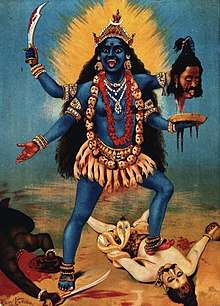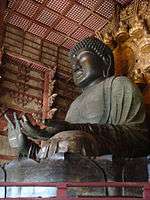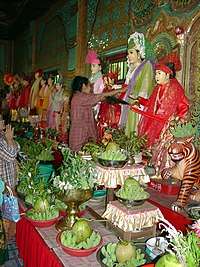Saraswati
Saraswati (Sanskrit: सरस्वती, IAST: Sarasvatī) is the Hindu goddess of knowledge, music, art, speech, wisdom, and learning.[4] She is a part of the trinity (Tridevi) of Saraswati, Lakshmi, and Parvati. All the three forms help the trinity of Brahma, Vishnu, and Shiva to create, maintain, and regenerate the Universe, respectively.[5]
| Saraswati | |
|---|---|
Goddess of Knowledge, Music, Art, Speech, Wisdom and Learning | |
| Member of Tridevi | |
 Saraswati by Raja Ravi Varma | |
| Other names | Sharda, Brahmani ,Brahmi , Savitri, Gayatri, Bharadi, Vani, Vāc, Varnesvari, Kavijihvagravasini , Vidyadatri , Veenavadini, Pustakdharini , Veenapani, Hansavahini and Vagdevi[1] |
| Devanagari | सरस्वती |
| Affiliation | Devi, River goddess, Tridevi, Mahasaraswati |
| Abode | Satyaloka |
| Mantra | ॐ ऐं महासरस्वत्यै नमः , om shree shree saraswatyai namaha. |
| Symbols | White colour, lotus, Veena , Saraswati river, books[2] |
| Mount | Swan or peacock |
| Festivals | Vasant Panchami and seventh day of Navratri |
| Personal information | |
| Siblings | Shiva |
| Consort | Brahma[3][4] |
| Part of a series on |
| Shaktism |
|---|
 |
|
Schools |
|
Festivals and temples |
|
|
The earliest known mention of Saraswati as a goddess is in the Rigveda. She has remained significant as a goddess from the Vedic period through modern times of Hindu traditions.[6] Some Hindus celebrate the festival of Vasant Panchami (the fifth day of spring, and also known as Saraswati Puja and Saraswati Jayanti in so many parts of India) in her honour,[7] and mark the day by helping young children learn how to write the letters of the alphabet on that day.[8] The Goddess is also revered by believers of the Jain religion of west and central India,[9] as well as some Buddhist sects.[10]
Etymology
Saraswati, is a Sanskrit fusion word of saras (सरस्) meaning "pooling water", but also sometimes translated as "speech"; and vati (वती) meaning "she who possesses". Originally associated with the river or rivers known as Saraswati, this combination, therefore, means "she who has ponds, lakes, and pooling water" or occasionally "she who possesses speech". It is also a Sanskrit composite word of surasa-vati (सरसु+अति) which means "one with plenty of water".[11][12]
The word Saraswati appears both as a reference to a river and as a significant deity in the Rigveda. In initial passages, the word refers to the Sarasvati River and is mentioned as one among several northwestern Indian rivers such as the Drishadvati. Saraswati, then, connotes a river deity. In Book 2, the Rigveda describes Saraswati as the best of mothers, of rivers, of goddesses.[12]
अम्बितमे नदीतमे देवितमे सरस्वति
— Rigveda 2.41.16[13]Best of mothers, the best of rivers, best of goddesses, Sarasvatī.
Saraswati is celebrated as a feminine deity with healing and purifying powers of abundant, flowing waters in Book 10 of the Rigveda, as follows:
अपो अस्मान मातरः शुन्धयन्तु घर्तेन नो घर्तप्वः पुनन्तु |
विश्वं हि रिप्रं परवहन्ति देविरुदिदाभ्यः शुचिरापूत एमि ||
— Rigveda 10.17[14]May the waters, the mothers, cleanse us,
may they who purify with butter, purify us with butter,
for these goddesses bear away defilement,
I come up out of them pure and cleansed.
— translated by John Muir
In Vedic literature, Saraswati acquires the same significance for early Indians (states John Muir) as that accredited to the river Ganges by their modern descendants. In hymns of Book 10 of Rigveda, she is already declared to be the "possessor of knowledge".[15] Her importance grows in Vedas composed after Rigveda and in Brahmanas, and the word evolves in its meaning from "waters that purify", to "that which purifies", to "vach (speech) that purifies", to "knowledge that purifies", and ultimately into a spiritual concept of a goddess that embodies knowledge, arts, music, melody, muse, language, rhetoric, eloquence, creative work and anything whose flow purifies the essence and self of a person.[12][16] In Upanishads and Dharma Sastras, Saraswati is invoked to remind the reader to meditate on virtue, virtuous emoluments, the meaning and the very essence of one's activity, one's action.
Saraswati is known by many names in ancient Hindu literature. Some examples of synonyms for Saraswati include Brahmani (power of Brahma), Brahmi (goddess of sciences),[17] Bharadi (goddess of history), Vani and Vachi (both referring to the flow of music/song, melodious speech, eloquent speaking respectively), Varnesvari (goddess of letters), Kavijihvagravasini (one who dwells on the tongue of poets).[4][1] The Goddess Saraswati is also known as Vidyadatri (Goddess who provides knowledge), Veenavadini (Goddess who plays Veena, the musical instrument held by Goddess Saraswati), Pustakdharini (Goddess who carries a book), Veenapani (Goddess who carries a veena in her hands), Hansavahini (Goddess who sits on swan) and Vagdevi (Goddess of speech).
In some interpretations, "Sara" is translated as "Essence", and "Sva" is translated to "Self". Thus, the name Saraswati would translate to "She who helps realize the essence of self" or "She who reconciles the essence (of Parabrahman) with one's self".
Nomenclature
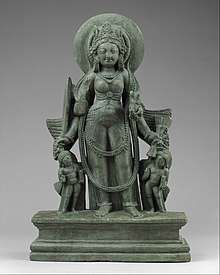
In the Hindi language, her name is written Hindi: सरस्वती. In the Telugu, Sarasvati is also known as Chaduvula Thalli (చదువుల తల్లి) and Shārada (శారద). In Konkani, she is referred to as Shārada, Veenapani, Pustakadhārini, Vidyadāyini. In Kannada, variants of her name include Sharade, Sharadamba, Vāni, Veenapani in the famous Sringeri temple. In Tamil, she is also known as Kalaimagal (கலைமகள்), Kalaivāni (கலைவாணி), Vāni (வாணி) and Bharathi. She is also addressed as Sāradā (the one who offers sāra or the essence), Shāradā (the one who loves the autumn season), Veenā-pustaka-dhārini (the one holding books and a Veena), Vāgdevi, Vāgishvari, (both meaning "goddess of speech"), Vāni (speech), Varadhanāyaki (the one bestowing boons), Sāvitri (consort of Brahma), Gāyatri (mother of Vedas).
In India, she is locally spelled as Assamese language:সৰস্বতী,Saraswati, Bengali: সরস্বতী, Saraswati ?, Malayalam: സരസ്വതി, Saraswati ?, and Tamil: சரஸ்வதி, Sarasvatī ?. In Odia as ସରସ୍ଵତୀ Saraswati.
Outside Nepal and India, she is known in Burmese as Thurathadi (သူရဿတီ, pronounced [θùja̰ðədì] or [θùɹa̰ðədì]) or Tipitaka Medaw (တိပိဋကမယ်တော်, pronounced [tḭpḭtəka̰ mɛ̀dɔ̀]), in Chinese as Biàncáitiān (辯才天), in Japanese as Benzaiten (弁才天/弁財天) and in Thai as Suratsawadi (สุรัสวดี) or Saratsawadi (สรัสวดี).[18]
History

In Hindu tradition, Sarasvati has retained her significance as a goddess from the Vedic age up to the present day.[6] In Shanti Parva of the Hindu epic Mahabharata, Saraswati is called the mother of the Vedas, and later as the celestial creative symphony who appeared when Brahma created the universe.[12] In Book 2 of Taittiriya Brahmana, she is called “the mother of eloquent speech and melodious music”. Saraswati is the active energy and power of Brahma.[1] She is also mentioned in many minor Sanskrit publications such as Sarada Tilaka of 8th century CE as follows,[20]
May the goddess of speech enable us to attain all possible eloquence,
she who wears on her locks a young moon,
who shines with exquisite lustre,
who sits reclined on a white lotus,
and from the crimson cusp of whose hands pours,
radiance on the implements of writing, and books produced by her favour.
– On Saraswati, Sarada Tilaka[20]
Saraswati became a prominent deity in Buddhist iconography – the consort of Manjushri in 1st millennium CE. In some instances such as in the Sadhanamala of Buddhist pantheon, she has been symbolically represented similar to regional Hindu iconography, but unlike the more well-known depictions of Saraswati.[10]
Symbolism and iconography
The goddess Saraswati is often depicted as a beautiful woman dressed in pure white, often seated on a white lotus, which symbolizes light, knowledge and truth.[21] She not only embodies knowledge but also the experience of the highest reality. Her iconography is typically in white themes from dress to flowers to swan – the colour symbolizing Sattwa Guna or purity, discrimination for true knowledge, insight and wisdom.[4][22]
Her dhyana mantra describes her to be as white as the moon, clad in a white dress, bedecked in white ornaments, radiating with beauty, holding a book and a pen in her hands (the book represents knowledge).[23]
She is generally shown to have four arms, but sometimes just two. When shown with four hands, those hands symbolically mirror her husband Brahma's four heads, representing manas (mind, sense), buddhi (intellect, reasoning), citta (imagination, creativity), and ahamkāra (self consciousness, ego).[24][25] Brahma represents the abstract, while she represents action and reality.
The four hands hold items with symbolic meaning — a pustaka (book or script), a mālā (rosary, garland), a water pot and a musical instrument (vīnā).[4] The book she holds symbolizes the Vedas representing the universal, divine, eternal, and true knowledge as well as all forms of learning. A mālā of crystals, representing the power of meditation, inner reflection, and spirituality. A pot of water represents the purifying power to separate right from wrong, the clean from the unclean, and essence from the inessential. In some texts, the pot of water is symbolism for soma – the drink that liberates and leads to knowledge.[4] The most famous feature on Saraswati is a musical instrument called a veena, represents all creative arts and sciences,[24] and her holding it symbolizes expressing knowledge that creates harmony.[4][26] Saraswati is also associated with anurāga, the love for and rhythm of music, which represents all emotions and feelings expressed in speech or music.
A hamsa or swan is often shown near her feet. In Hindu mythology, the hamsa is a sacred bird, which if offered a mixture of milk and water, is said to be able to drink the milk alone. It thus symbolizes the ability to discriminate between good and evil, essence from the outward show, and the eternal from the evanescent.[24] Due to her association with the swan, Saraswati is also referred to as Hamsavāhini, which means “she who has a hamsa as her vehicle”. The swan is also a symbolism for spiritual perfection, transcendence and moksha.[22][27]
Sometimes a citramekhala (also called mayura, peacock) is shown beside the goddess. The peacock symbolizes colorful splendor, the celebration of dance, and – as the devourer of snakes – the alchemical ability to transmute the serpent poison of self into the radiant plumage of enlightenment.[28]
She is usually depicted near a flowing river or another body of water, which depiction may constitute a reference to her early history as a river goddess.
She is a part of the Tridevi, the triad of great Goddesses. She represents the Sattwa Guna, and Jnana Shakti.
Saraswati as a river
Devi Saraswati was initially a river goddess in early texts like the Rigveda. She was the personification of the Saraswati river, which is a symbol of purity.[29] The story of Devi Saraswati becoming a river is mentioned below.
In some texts, it is written that once there was a terrible battle between the Bhargavas and Hehayas, and from this an all-consuming fire called Vadavagni was born which could destroy the whole world. The devas were worried and they went to Shiva. Shiva suggested that they should go to Saraswati for help as she can become a river and immerse the Vadavagni in the ocean. All the devas and devis went to Saraswati and requested her to protect the universe. She said that she would only agree if her disciple, Bramha told her to do so. Then they all went to Bramha and Bramha told Saraswati to become a river. Saraswati agreed and left Brahmaloka and arrived at sage uttanka's ashram. There she met Shiva. He gave the Vadavagni in a pot to Saraswati and told her to originate from Plaksha tree. Saraswati merged with the tree and transformed into a river. From there she flowed towards Pushkar.[30]
Saraswati continued her journey towards the ocean. At last, she reached the end of her journey and immersed the fire in the ocean.[31]
Regional manifestations of Saraswati
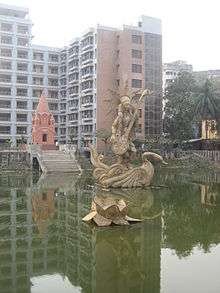
Avatars
There are many avatars and forms of Goddess Saraswati.
She is venerated as Mahasaraswati in the Kashmir Shakti Peetha, as Vidhya Saraswati in Basara and Vargal, and as Sharadamba in sringeri.
She takes her Matrika (Warrior) avatar as Brahmani. Saraswati is not just the goddess of knowledge and wisdom but also she is the Brahmavidya herself, the goddess of the wisdom of ultimate truth. Her Mahavidhya forms are Matangi and Tara Mahavidya she manifests:
- As Mahakali, she is the destroyer of ignorance and ego, and the darkness that surrounds the mind of the unlearned and lethargic.
- As Parvati, she is Brahmavidhya, the ultimate truth.
- As Lakshmi, she is Vidhyalakshmi, who provides wealth according to skill.
- As Vidhya, she is the formless concept of wisdom and knowledge in all of its aspects.
- As Gayatri, she is the personification of the Vedas.
- As Savitri, She is the personification of purity, consort of Lord Brahma
Maha Saraswati
In some regions of India, such as Vindhya, Odisha, West Bengal and Assam, as well as east Nepal, Saraswati is part of the Devi Mahatmya mythology, in the trinity (Tridevi) of Mahakali, Mahalakshmi and Mahasaraswati.[32][33] This is one of many different Hindu legends that attempt to explain how the Hindu trinity of gods (Brahma, Vishnu and Shiva) and goddesses (Saraswati, Lakshmi and Parvati) came into being. Various Purana texts offer alternate legends for Maha Saraswati.[34]
Maha Saraswati is depicted as eight-armed and is often portrayed holding a Veena whilst sitting on a white lotus flower.
Her dhyāna shloka given at the beginning of the fifth chapter of Devi Mahatmya is: Wielding in her lotus-hands the bell, trident, ploughshare, conch, pestle, discus, bow, and arrow, her lustre is like that of a moon shining in the autumn sky. She is born from the body of Gauri and is the sustaining base of the three worlds. That Mahasaraswati I worship here who destroyed Sumbha and other asuras.[35]
Mahasaraswati is also part of another legend, the Navshaktis (not to be confused with Navdurgas), or nine forms of Shakti, namely Brahmi, Vaishnavi, Maheshwari, Kaumari, Varahi, Narsimhi, Aindri, Shivdooti, and Chamunda, revered as powerful and dangerous goddesses in eastern India. They have special significance on Navaratri in these regions. All of these are seen ultimately as aspects of a single great Hindu goddess, with Maha Saraswati as one of those nine.[36]
Mahavidya Nila Saraswati
In Tibet and parts of India, Nilasaraswati is sometimes considered as a form of Mahavidya Tara. Nila Saraswati is not much a different deity from traditional Saraswati, who subsumes her knowledge and creative energy in tantric literature. Though the traditional form of Saraswati is of calm, compassionate, and peaceful one: Nila Sarasvati is the ugra (angry, violent, destructive) manifestation in one school of Hinduism, while the more common Saraswati is the saumya (calm, compassionate, productive) manifestation found in most others. In tantric literature of the former, Nilasaraswati has 100 names. There are separate dhyana shlokas and mantras for her worship in Tantrasara.[6] She is worshipped in parts of India as an incarnate or incarnation of Goddess Tara but mostly outside India. She is not only worshipped but also been manifested as a form of Goddess Saraswati.
Sharada avatar in Kashmir and Haryana
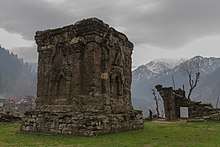
Sharada Peeth is a ruined Hindu temple and ancient centre of learning located in present-day Azad Kashmir. Between the 6th and 12th centuries CE, it was among the most prominent temple universities in the Indian subcontinent. Famed for its library, stories recount eminent scholars travelling long distances to access its texts. It played a key role in the development and popularisation of the Sharada script in North India, causing the script to be named after it, and Kashmir to acquire the moniker "Sharada Desh", meaning "country of Sharada".
As one of the Maha Shakti Peethas, Hindus believe that it represents the spiritual location of the goddess Sati's fallen right hand. Sharada Peeth is one of the three holiest sites of pilgrimage for Kashmiri Pandits, alongside the Martand Sun Temple and the Amarnath Temple. As part of INR1200 crore Morni to Kalesar tourism development plan announced in January 2019, Government of Haryana is developing the historic Sharda Mata Temple of Chotta Trilokpur, along with Kalesar Mahadev temple, Kapal Mochan Tirth, Panchmukhi Hanuman temple of Basatiyawala, Lohgarh fort capital of Banda Singh Bahadur.[37]
Saraswati in Jainism

Saraswati is also revered in Jainism as Goddess of knowledge and regarded as source of all learning. Saraswati is depicted in standing posture with 4 hands, one holding text, other holding a rosary and two hands holding Veena. Saraswati is seated on lotus with peacock as her vehicle.[38] Saraswati is also regarded as responsible for dissemination of tirthankars sermon.[39] The earliest sculpture of Saraswati in any religious tradition is the Mathura Jain Saraswati from Kankali Tila dating 132 CE.[40]
Worship
Temples
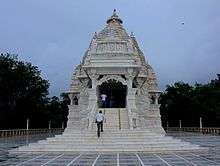
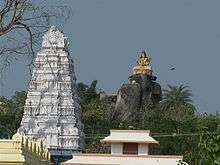
Ancient Sharada Peeth in Pakistan’s Azad Kashmir is one of the oldest surviving temples of Saraswati.
There are many temples dedicated to Saraswati around the world. Some notable temples include the Gnana Saraswati Temple in Basar on the banks of the River Godavari, the Warangal Saraswati and Shri Saraswati Kshetramu temples in Medak, Telangana. In Karnataka, one of many Saraswati/Sharada pilgrimage spots is Shringeri Sharadamba Temple. In Ernakulam district of Kerala, there is a famous Saraswati temple in North Paravur, namely Dakshina Mookambika Temple North Paravur. In Tamil Nadu, Koothanur hosts a Saraswati temple at Koothanur in Tamil Nadu about 25 kilometres from Tiruvarur. In her identity as Brahmani, additional Sarasvati temples can be found throughout Gujarat, Himachal Pradesh, Rajasthan, and Uttar Pradesh.
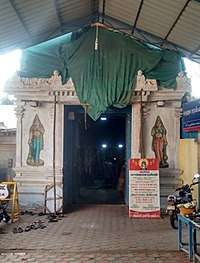
Festivals
One of the most famous festivals associated with Goddess Saraswati is the Hindu festival of Vasant Panchami. Celebrated on the 5th day in the Hindu calendar month of Magha (month), it is also known as Saraswati Puja and Saraswati Jayanti in India.
Saraswati Puja in East and Northeast India

In Assam , Odisha, West Bengal and Tripura, Goddess Saraswati is worshipped on Vasant Panchami, a Hindu festival celebrated every year on the 5th day in the Hindu calendar month of Magha (about February). Hindus celebrate this festival in temples, homes and educational institutes alike.[41][42]
Saraswati Puja in North, West and Central India
In Bihar and Jharkhand, Vasant Panchami is commonly known as Saraswati Puja. On this day, Goddess Saraswati is worshipped in schools, colleges, educational institutes as well as in institutes associated with music and dance. Cultural programmes are also organised in schools and institutes on this day. People especially students worship Goddess Saraswati also in pandals (a tent made up of colourful cloths, decorated with lights and other decorative items). In these states, on the occasion of Saraswati Puja, Goddess Saraswati is worshipped in the form of idol, made up of soil. On Saraswati Puja, the idol is worshipped by people and prasad is distributed among the devotees after puja. Prasad mainly consists of boondi (motichoor), pieces of carrot, peas and Indian plum (ber). On the next day or any day depending on religious condition, the idol is immersed in a pond (known as Murti Visarjan or Pratima Visarjan) after performing a Havana (immolation), with full joy and fun, playing with abir and gulal. After Pratima Visarjan, members involved in the organisation of puja ceremony eat khichdi together.
In Goa,[43] Maharashtra and Karnataka, Saraswati Puja starts with Saraswati Avahan on Maha Saptami and ends on Vijayadashami with Saraswati Udasan or Visarjan.
In 2018, the Haryana government launched and sponsored the annual National Saraswati Mahotsav in its state named after Saraswati.[44]
Saraswati Puja in South India
In Kerala and Tamil Nadu, the last three days of the Navaratri festival, i.e., Ashtami, Navami, and Dashami, are celebrated as Sarasvati Puja.[45]
The celebrations start with the Puja Vypu (Placing for Worship). It consists of placing the books for puja on the Ashtami day. It may be in one's own house, in the local nursery school run by traditional teachers, or in the local temple. The books will be taken out for reading, after worship, only on the morning of the third day (Vijaya Dashami). It is called Puja Eduppu (Taking [from] Puja). Children are happy, since they are not expected to study on these days. On the Vijaya Dashami day, Kerala and Tamil Nadu celebrate the Ezhuthiniruthu or Initiation of Writing for the little children before they are admitted to nursery schools. This is also called Vidyarambham. The child is made to write for the first time on the rice spread in a plate with the index finger, guided by an elder of the family or by a teacher.[46]
During the Navratri festivities, on the seventh day, which coincides with the Moola nakshatra (which is considered to be Devi's birth star), the Goddesses in various temples are decorated and worshipped in the form of Mahasaraswati,in honor of the Goddess of knowledge, wisdom, arts, and learning. Students throng these temples in large numbers and receive books, pencils, pens and other learning equipment as "Devi prasadam". "Aksharabhyasa", the ceremony of initiating a child into the process of learning, is held on a large scale across these temples.
Outside the Indian subcontinent
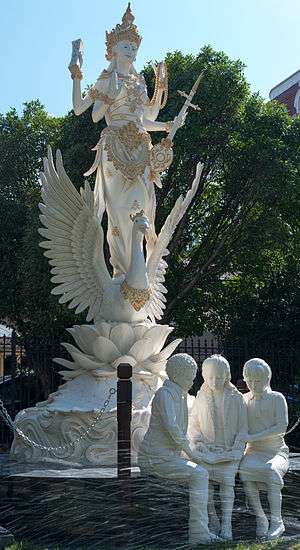
.jpg)
Myanmar
In Burma, the Shwezigon Mon Inscription dated to be of 1084 AD, near Bagan, recites the name Saraswati as follows,
- "The wisdom of eloquence called Saraswati shall dwell in the mouth of King Sri Tribhuwanadityadhammaraja at all times". – Translated by Than Tun[47]
In Buddhist arts of Myanmar, she is called Thurathadi (or Thayéthadi).[48]:215 Students in Myanmar pray for her blessings before their exams.[48]:327 She is also believed to be, in Mahayana pantheon of Myanmar, the protector of Buddhist scriptures.[49]
Japan
The concept of Saraswati migrated from India, through China to Japan, where she appears as Benzaiten (弁財天).[50] Worship of Benzaiten arrived in Japan during the 6th through 8th centuries. She is often depicted holding a biwa, a traditional Japanese lute musical instrument. She is enshrined on numerous locations throughout Japan such as the Kamakura's Zeniarai Benzaiten Ugafuku Shrine or Nagoya's Kawahara Shrine;[51] the three biggest shrines in Japan in her honour are at the Enoshima Island in Sagami Bay, the Chikubu Island in Lake Biwa, and the Itsukushima Island in Seto Inland Sea.
Cambodia
Saraswati was honoured with invocations among Hindus of Angkorian Cambodia, suggests a tenth-century and another eleventh-century inscription.[52] She and Brahma are referred to in Cambodian epigraphy from the 7th century onwards, and she is praised by Khmer poets for being the goddess of eloquence, writing, and music. More offerings were made to her than to her husband Brahma. She is also referred to as Vagisvari and Bharati in Yasovarman era Khmer literature.[52]
Thailand
In ancient Thai literature, Saraswati (Thai: สุรัสวดี; RTGS: Suratsawadi) is the goddess of speech and learning, and consort of Brahma.[53] Over time, Hindu and Buddhist concepts on deities merged in Thailand. Icons of Saraswati with other deities of India are found in old Thai wats.[54] Amulets with Saraswati and a peacock are also found in Thailand.
Indonesia
Watugunung, the last day of the pawukon calendar, is devoted to Saraswati, goddess of learning. Although it is devoted to books, reading is not allowed. The fourth day of the year is called Pagerwesi, meaning "iron fence". It commemorates a battle between good and evil.[55]
Saraswati is an important goddess in Balinese Hinduism. She shares the same attributes and iconography as Saraswati in Hindu literature of India – in both places, she is the goddess of knowledge, creative arts, wisdom, language, learning and purity. In Bali, she is celebrated on Saraswati day, one of the main festivals for Hindus in Indonesia.[56][57] The day marks the close of 210 day year in the Pawukon calendar.[58]
On Saraswati day, people make offerings in the form of flowers in temples and to sacred texts. The day after Saraswati day, is Banyu Pinaruh, a day of cleansing. On this day, Hindus of Bali go to the sea, sacred waterfalls or river spots, offer prayers to Saraswati, and then rinse themselves in that water in the morning. Then they prepare a feast, such as the traditional bebek betutu and nasi kuning, that they share.[59]
The Saraswati Day festival has a long history in Bali.[60] It has become more widespread in Hindu community of Indonesia in recent decades, and it is celebrated with theatre and dance performance.[58]
Tibet
In Tibet, she is known as the Goddess of Music (Tibetan: དབྱངས་ཅན་མ, Wylie: dbyangs can ma, THL: yang chen ma ),[61] or the Tara of Music (Tibetan: དབྱངས་ཅན་སྒྲོལ་མ, Wylie: dbyangs can sgrol ma, THL: yang chen dröl ma ), considered the consort of Mañjuśri, Buddha of Wisdom, she is one of the 21 Taras.[62][63]
Saraswati is the Divine Embodiment & bestower of Enlightened Eloquence & Inspiration, patroness of the arts, sciences, music, language, literature, history, poetry & philosophy, all those engaged in creative endeavours in Tibetan Buddhism. She is considered the peaceful manifestation of Palden Lhamo (Glorious Goddess). In the Gelugpa tradition, Palden Lhamo is known as Magzor Gyalmo (the Queen who Repels Armies[64]) and is a wrathful emanation of Saraswati while being a protector. Saraswati was the yidam (principal personal meditational deity) of 14th century Tibetan monk Je Tsongkhapa. He composed a devotional poem to her.[65][66] She is believed in the Tibetan tradition to have accompanied him on his travels, as well as regularly engaging in conversations with him.
See also
- Aban, "the Waters", representing and represented by Aredvi Sura Anahita.
- Anahita – the Old Persian goddess of wisdom
- Arachosia name of which derives from Old Iranian *Harahvatī (Avestan Haraxˇaitī, Old Persian Hara(h)uvati-).
- Athena – the Greek goddess of wisdom and knowledge
- Sága – the Norse goddess of learning and knowledge
- Brahmi – Shaktidharmic version of Saraswati
- Hara Berezaiti, "High Hara", the mythical mountain that is the origin of the *Harahvatī river.
- Minerva – the Roman goddess of wisdom and knowledge
- Rhea – the Greek goddess consort of Cronos and mother of the gods and titans.
- Saraswati Puja
- Sarasvati River, a manifestation of the goddess Saraswati.
- Saraswati Vandana Mantra
- Saraswati yoga
- Sharada Peeth
- Tara (Devi)
- Tridevi
- Trikaranasuddhi
- Koothanur Maha Saraswathi Temple
Citations
- Balf, Edward. The Encyclopædia of India and of Eastern and Southern Asia. p. 534 – via Google Books.
- https://en.m.wikipedia.org/wiki/Saraswati#cite_note-Kinsley1988-2
- Dowling, Elizabeth; Scarlett, W George (2005). Encyclopedia of Religious and Spiritual Development. SAGE Publications. p. 204. ISBN 978-0761928836.
- Kinsley, David (1988). Hindu Goddesses: Vision of the divine feminine in the Hindu religious traditions. University of California Press. pp. 55–64. ISBN 0-520063392.
- Encyclopaedia of Hinduism. Sarup & Sons. p. 1214. ISBN 978-81-7625-064-1.
- Kinsley, David (1988). Hindu Goddesses: Vision of the divine feminine in the Hindu religious traditions. University of California Press. ISBN 0-520-06339-2.
- "Vasant Panchami Saraswati Puja". Know India – Odisha Fairs and Festivals. Archived from the original on 23 September 2014.
- "The festival of Vasant Panchami: A new beginning". United Kingdom: Alan Barker. Archived from the original on 4 October 2015.
- Guide to the collection. Birmingham Museum of Art. Birmingham, Alabama: Birmingham Museum of Art. 2010. p. 55. ISBN 978-1-904832-77-5. Archived from the original on 14 May 1998.
- Donaldson, Thomas (2001). Iconography of the Buddhist Sculpture of Orissa. pp. 274–275. ISBN 978-8170174066.
- "सुरस". Sanskrit English Dictionary,. Koeln, Germany: University of Koeln. Archived from the original on 4 December 2014.
- Muir, John. Original Sanskrit Texts on the Origin and History of the People of India – Their Religions and Institutions. 5. pp. 337–347 – via Google Books.
- "Rigveda". Book 2, Hymn 41, line 16. Archived from the original on 24 September 2015.
- "Rigveda". Book 10, Hymn 17. Archived from the original on 8 May 2015.
- Colbrooke, H.T. Sacred writings of the Hindus. London, UK: Williams & Norgate. pp. 16–17. Archived from the original on 10 March 2016.
- Moor, Edward. The Hindu Pantheon. pp. 125–127 – via Google Books.
- "Sarasvati, The Goddess of Learning". Stephen Knapp. Archived from the original on 27 April 2009.
- Kinsley, David (1988). Hindu Goddesses: Vision of the divine feminine in the Hindu religious traditions. University of California Press. p. 95. ISBN 0-520-06339-2 – via Google Books.
- Reader, Ian; Tanabe, George J. Practically Religious: Worldly benefits and the common religion of Japan. University of Hawaii Press. ISBN 978-0824820909.
- History and Antiquities, the Arts, Sciences and Literature of Asia. Asiatic Researches. 3. London, UK. pp. 272–273 – via Google Books.
- Ludvík, Catherine (2007). Sarasvatī, Riverine Goddess of Knowledge: From the Manuscript-carrying Vīṇā-player to the Weapon-wielding Defender of the Dharma. BRILL. p. 1.
- Holm, Jean; Bowke, John (1998). Picturing God. Bloomsbury Academic. pp. 99–101. ISBN 978-1855671010.
- "Hinduism 101 Saraswati Symbolism". Hindu American Foundation (HAF). Archived from the original on 16 October 2017. Retrieved 10 February 2018.
- Pollock, Griselda; Turvey-Sauron, Victoria (2008). The Sacred and the Feminine: Imagination and sexual difference. pp. 144–147. ISBN 978-1845115203.
- For Sanskrit to English translation of the four words: "Monier Williams' Sanskrit-English Dictionary". Koeln, Germany: University of Koeln. Archived from the original on 20 August 2016.
- Some texts refer to her as "goddess of harmony"; for example: Wilkes, John. Encyclopaedia Londinensis. 22. p. 669 – via Google Books.
- Schuon, Frithjof (2007). Spiritual Perspectives and Human Facts. p. 281. ISBN 978-1933316420.
- Werness, Hope B. (2007). Animal Symbolism in World Art. Continuum Encyclopedia. Bloomsbury Academic. pp. 319–320. ISBN 978-0826419132.
- https://www.ancient-origins.net/news-general/did-mythical-saraswati-river-ancient-vedas-really-exist-002174
- Kapur, Sanjana. Saraswati. Amar Chitra Katha Private limited. ISBN 978-93-5085-120-3.
- Saraswati. Amar Chitra Katha. ISBN 978-93-5085-120-3.
- Lochtefeld, James (2002). The Illustrated Encyclopedia of Hinduism. A–M. p. 408. ISBN 978-0823931804.
- Eck, Diana L. (2013). India: A sacred geography. Random House. pp. 265–279. ISBN 978-0385531924.
- Brown, C. Mackenzie (1990). The Triumph of the Goddess. State University of New York Press. ISBN 978-0791403648.
- Glory of the Divine Mother (Devi Mahatmyam) by S.Sankaranarayanan. Prabha Publishers, Chennai. India.(ISBN 81-87936-00-2) Page. 184
- Lochtefeld, James. The Illustrated Encyclopedia of Hinduism. N–Z. p. 467. ISBN 978-0823931804.
- "Kalesar-Kalka stretch to be promoted for tourism". The Tribune. 18 January 2019.
- Jain 2009, p. 63.
- Prasad 2017, p. 192.
- Kelting 2001.
- Roy, Christian (2005). Traditional Festivals: A multicultural encyclopedia. 2. ABC-CLIO. pp. 192–193. ISBN 9781576070895.
- Knapp, Stephen (2006). "The Dharmic Festivals". The Power of the Dharma: An introduction to Hinduism and Vedic culture. iUniverse. p. 94. ISBN 9780595837489.
- Kerkar, Rajendra (5 October 2011). "Saraswati Puja: Worshipping knowledge, education". Times of India. Archived from the original on 10 June 2018. Retrieved 19 October 2015.
- "Haryana to celebrate Saraswati Mahotsav on Jan 28". The Daily Pioneer. 7 January 2017. Archived from the original on 17 January 2018.
- "Navratri rituals: Golu, Saraswati Puja, Vidyarambham ..." The Deccan Chronicle. 5 October 2013. p. 4. Archived from the original on 15 October 2013.
- "Thiruvananthapuram gears up for Vidyarambham day". The Hindu. 11 October 2013. Archived from the original on 14 October 2013.
- Than Tun (December 1976). "Saraswati of Burma" (PDF). South East Asian Studies. 14 (3): 433–441. Archived from the original (PDF) on 4 December 2014.
- Seekins, Donald (2006). Historical Dictionary of Burma (Myanmar). ISBN 978-0810854765.
- Silverstein, Josef (1989). Independent Burma at forty years. Monograph Southeast Asia Program. 4. Cornell University. p. 55. ISBN 978-0877271215.
- Ludvik, Catherine (2001). From Sarasvati to Benzaiten (PDF) (Ph.D.). University of Toronto: National Library of Canada. Archived from the original (PDF download) on 11 September 2014.
- Suzuki, T. (1907). "The seven gods of bliss". The Open Court. Vol. 7 no. 2. Archived from the original on 7 April 2014.
- Wolters, O.W. (1989). History, Culture, and Region in Southeast Asian Perspectives. pp. 87–89. ISBN 978-9971902421.
- McFarland, George. Thai-English Dictionary. p. 790 – via Google Books.
- Patit Paban Mishra (2010). The History of Thailand. ISBN 978-0313340918.
- Eiseman (1989) pp 184–185
- "Saraswati, day of knowledge descent". The Bali Times. 2013. Archived from the original on 5 December 2014.
- Pande, G.C. India's Interaction with Southeast Asia. 1. pp. 660–661. ISBN 978-8187586241.
- Zurbuchen, Mary Sabine (2014). The Language of Balinese Shadow Theater. Princeton University Press. pp. 49–57. ISBN 978-0691608129.
- Kruger, Vivienne. Balinese Food: The traditional cuisine & food culture of Bali. pp. 152–153. ISBN 978-0804844505.
- Gonda, Jan. "Section 3: Southeast Asia Religions". Handbook of Oriental Studies. Brill Academic. p. 45. ISBN 978-9004043305.
- Jamgon Mipham (2000). Mo: The Tibetan Divination System. Shambhala. pp. 149–150. ISBN 978-1-55939-848-0 – via Google Books.
- Khenchen Palden Sherab (2007). Tara's Enlightened Activity: An oral commentary on the twenty-one praises to Tara. Shambhala. pp. 65–68. ISBN 978-1-55939-864-0 – via Google Books.
- Jampa Mackenzie Stewart (2014). The Life of Longchenpa: The Omniscient Dharma King of the Vast Expanse. Shambhala Publications. ISBN 978-0-8348-2911-4 – via Google Books.
- "Buddhist Protector: Shri Devi, Magzor Gyalmo Main Page". www.himalayanart.org. Archived from the original on 26 October 2017. Retrieved 26 October 2017.
- "Prayer to Sarasvati" – via Google Books.
- Kilty, Gavin (15 June 2001). The Splendor of an Autumn Moon: The devotional verse of Tsongkhapa. Wisdom Publications. ISBN 0861711920. Archived from the original on 25 January 2018. Retrieved 24 January 2018.
Also: "The Splendor of an Autumn Moon: The devotional verse of Tsongkhapa". Retrieved 24 January 2018 – via Google Books.
References

- Kinsley, David (1998). Tantric Visions of the Divine Feminine: The ten mahāvidyās (Repr. ed.). Delhi: Motilal Banarsidass. ISBN 81-208-1523-8.
- Sankaranarayanan, S. (2001). Glory of the Divine Mother (Devī Māhātmyam). India: Nesma Books. ISBN 81-87936-00-2.
- Jain, Arun Kumar (2009), Faith & Philosophy of Jainism, Gyan Publishing House, ISBN 9788178357232, retrieved 8 October 2017
- Prasad, R.U.S. (2017), River and Goddess Worship in India: Changing Perceptions and Manifestations of Sarasvati, Routledge, ISBN 9781351806541
- Kelting, M. Whitney (2001), Singing to the Jinas: Jain Laywomen, Mandal Singing, and the Negotiations of Jain Devotion, Oxford University Press, ISBN 9780198032113
Further reading
- Sailen Debnath, The Meanings of Hindu Gods, Goddesses and Myths, ISBN 9788129114815, Rupa & Co., New Delhi.
- Saraswati, Swami Satyananda. Saraswati Puja for Children. ISBN 1-877795-31-3.
- Ankerl, Guy (2000). Coexisting contemporary civilizations: Arabo-Muslim, Bharati, Chinese, and Western. INU societal research: Global communication without universal civilization. 1. Geneva: INU Press. ISBN 2-88155-004-5.
External links
| Wikiquote has quotations related to: Saraswati |
| Wikimedia Commons has media related to Sarasvati. |
- "Sarasvati". Encyclopædia Britannica.
- "Sarasvati, The Goddess of Learning". Stephen Knapp.
- Je Tsongkhapa. "Prayer to Sarasvati". Wisdom Publications. The Splendor of an Autumn Moon The Devotional Verse of Tsongkhapa. Translated by Gavin Kilty – via Google Books.


